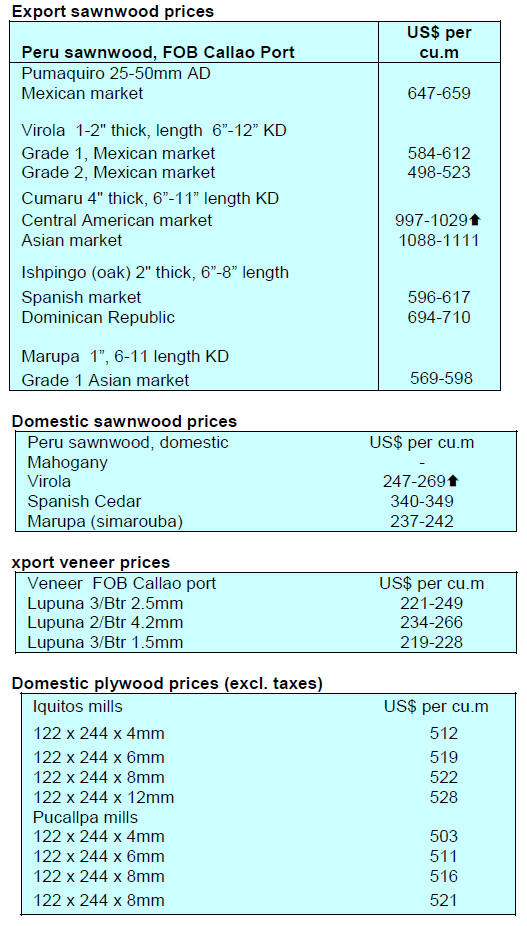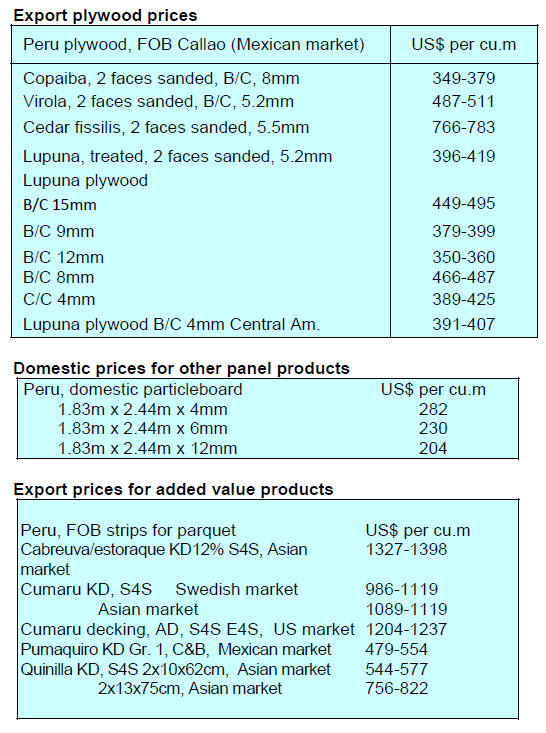4.
INDONESIA
SVLK centre for forest farmers,
traders and SMEs
The Secretary of the Directorate General of Sustainable
Production Forest Management (PHPL) in the Ministry of
Environment and Forestry, Misran, has emphasised the
importance of ensuring that timber coming onto the
market must come from legal sources.
To ensure this the government has strengthened the
capacity of the private sector through application of the
Timber Legality Verification System (SVLK) and the
Community Based Forest Enterprises. This, said Misran,
was achieved through the Multi-stakeholder Forestry
Programme Phase 4 (MFP4).
To further encourage the growth of legally processed
wood the Ministry together with MFP4, Javlec (Java
Learning Center / NGO) and industry associations built a
SVLK clinic to serve community forest farmers, traders
and SMEs needing advice on SVLK implementation and
procedures.
See:
https://lenterasultra.com/blog/2021/05/04/indonesia-dorongpenguatan-kapasitas-pelaku-usaha-hutan-melalui-svlk/
Indonesian teak furniture a favourite in India
The Head of the Indonesian Trade Promotion Center in
Chennai, Kumara Jati, has reported that there is demand in
India for some products such as household furniture, home
décor items and handicraft made by Indonesian SMEs. He
added that sales of these products increased over the past
year despite the pandemic and the preference was for teak
furniture.
See:
https://money.kompas.com/read/2021/05/03/160022426/produkfurnitur-hingga-handycraft-buatan-umkm-indonesia-diminati-diindia
Indonesian furniture exports up but far behind
Vietnam’s
The Chairman of the Indonesian Furniture and Craft
Industry Association (HIMKI), Abdul Sobur, commented
on Indonesia’s 5-6% increase in furniture exports during
the pandemic helped, he pointed out, by the trade friction
between the US and China. But, said Sobur, the 5-6%
increase was nothing compared to what was achieved by
Vietnam where exports were four times higher than those
by Indonesia. According to Sobur, Indonesia has a chance
to expand exports especially to the US.
In related news, Sobur said the Association encourages
furniture makers to expand sales in the domestic market
but admitted that the current export market is much more
attractive than the domestic market. However, he urged
manufacturers not to underestimate the domestic market
and to diversify sales. He reported that in 2020, total
furniture imports were in the region of IDR10 trillion
indicating the growth potential in the local market.
See:
https://ekbis.sindonews.com/read/414408/34/eksporfurnitur-ri-naik-5-imbas-perang-dagang-tapi-kalah-jauh-darivietnam-1619795094
Structural reforms to boost economic growth: Finance
Minister
The Finance Minister, Sri Mulyani Indrawati, has said the
structural reforms being carried out by the government
will boost growth of by over 6% in 2025. The reforms
cover five strategic policies; human resource development,
infrastructure development, bureaucratic reform,
simplification of regulations and economic transformation.
The main impact will be on expanded investment and
exports.
See:
https://www.thejakartapost.com/news/2021/04/29/srimulyani-sets-sights-on-6-gdp-growth-by-2023-throughreform.html
Multi-business forestry model for climate change
mitigation
Environmental services in a multi-business forestry model
could, according to Siti Nurbaya, Minister of Environment
and Forestry, be part of climate change mitigation action
by the forestry sector. The contribution to climate change
mitigation efforts by enterprises could be through
activities that can reduce emissions and/or increase carbon
sequestration.
The Minister said the government encourages forestry
entrepreneurs to adopt a multi-purpose business model so
they can contribute to strengthening and supporting
climate change mitigation. This will be the challenge for
forestry entrepreneurs in the future.
This theme was taken up by the chairman of the
Association of Indonesian Forest Concessionaires (APHI),
Indroyono Soesilo, who said adaptation and mitigation
activities in climate change are important factors in efforts
to achieve Indonesia's Nationally Determined Contribution
(NDC) target and that businesses and other non-state
stakeholders are also an important part of this process.
The ability to calculate potential emission reduction is
crucial for businesses to determine their contribution to
adaptation and mitigation and earn Carbon Economic
Value (NEK) credits through both Results Based Payment
and carbon trading schemes.
He estimates the potential for emission reduction from
natural forests, plantation forests and ecosystem
restoration would make a huge contribution in fulfilling
Indonesia's NDC goals.
He said incentives absorption of carbon emissions in
natural forest areas and plantation forests can be obtained
through conservation and management of peatlands, the
application of Reduced Impact Logging (RIL) and
extension of planting and harvesting time in industrial
plantations along with reducing the area logged in natural
forests.
See:
https://investor.id/business/aphi-pelaku-usaha-harus-terlibatdalam-penghitungan-potensi-penurunan-emisi

5.
MYANMAR
Forest resource policy of military
administration
The Foretry Minister, Khin Maung Yi, was quoted by the
state-owned newspaper “The New Light of Myanmar” as
saying the priority of the administration regarding timber
extraction will be forest protection, only the minimum
harvest to meet demand will be permitted. He added that
the export of logs has been banned since 2014 and logging
in Bago Yoma has been suspended for ten years. It was
earlier announced that logging during the financial year
2021-2022 will be suspended.
With regard to the development of the wood-based
industry in the country the Minister said the focus will be
on value-added wood products and the Forest Department
and the private sector should work together to achieve this
and expand export markets. However, some NGOs are
urging a boycott of timber from Myanmar since the
income derived from exports will support the military.
Regarding the one-year logging ban for 2021-2022 the
website of Myanma Timber Enterprise (MTE) uploaded
the official notification from the Ministry dated 27 April
2021. Initially, MTE had targeted to harvest 6,000 tons of
teak logs and 220,000 tons of other hardwood logs.
The frequent suspension of monthly log tender sales as
result of anti-covid19 preventive measures and the decline
in milling has resulted in a build-up of log stocks.
According to exporters the suspension of export licenses
for sawnwood has not yet been revoked and they are
waiting for their licenses.
However, even if the licenses are issued the challenge now
for exporters is the availability of containers. The cost of a
20ft container for the route to Europe has surged to around
US$6,000. Last year the cost was just US$1,800 per
container.
See:
https://www.gnlm.com.mm/coordination-meeting-discussesenvironmental-forest-and-mining-sectors/#article-title
100 days of military administration – the impact
Tthe online Irrawaddy News published a review of the
economic impact of the coup and resistance. The
following are highlights from the Irrawaddy article:
Foreign investors suspended more than US$6
billion (9.4 trillion kyats) worth of projects.
Work on a US$1 billion industrial hub backed by
the Amata Corporation, Thailand’s largest
industrial real estate developer, was suspended.
A major Japanese car market has delayed opening
its US$52.6 million vehicle plant in the Thilawa
Special Economic Zone.
A Singaporean conglomerate halted plans to
develop an industrial park in Yangon’s Hlegu
Township.
The French energy company, Électricité de
France, has suspended a hydropower project,
worth more than US$1.5 billion in Shan State.
Myanmar’s banking system has been paralysed
since the coup with branches closed for nearly
three months, cash shortages and limited access
to social welfare payments and international
remittances for hard-pressed families.
All sea trade has ceased as banks are unable to
issue documents needed to import and export
goods.
Companies are struggling to pay salaries as banks
are not able to process payrolls.
Since mid-February businesses have suffered
from a cash shortages.
Most private banks started to reopen in late April
amid repeated threats of penalties and orders to
blacklist staff who refuse to return to work.
The kyat has tumbled in value as confidence and
trade fell, losing more than 20% since the coup.
Exports have fallen by around 45% and imports
are down by 65%.
The garment sector has been paralysed as out of
fear workers to returned to their hometowns.
The trade unions said over 300,000 garment
workers have lost their jobs.
The Construction Workers Union said around
300,000 to 400,000 construction jobs have gone
as all major infrastructure projects are halted in
Yangon.
Professional jobs are also being lost. Job agencies
said hundreds of staff working for foreign
companies are losing their jobs.
See:
https://www.irrawaddy.com/news/burma/100-days-sincemyanmars-coup-looming-economic-collapse-poverty-andhunger.html
Significant risk of economic collapse - UN
A United Nations Development Programme report
concludes that Myanmar’s economy is facing significant
risks of collapse and the level of poverty is as bad as in
2005.
Over the past 10 years, Myanmar’s average economic
growth has exceeded 6%. However, the World Bank has
now projected growth to contract by 10% this year
because of the coup, by far the biggest contraction in Asia
which is already reeling from the impact of coronavirus.
The United Nations World Food Program (WFP) warned
that up to 3.4 million citizens could go hungry this year
amid rising food prices and the loss of manufacturing,
construction and services jobs. The WFP estimated that
food insecurity is rising sharply in Myanmar alongside
food prices and joblessness. It said COVID-19 concerns
are also accelerating the economic deterioration and
humanitarian crisis.
The UNDP estimated that the impact of military rule and
the COVID-19 pandemic could force nearly half of
Myanmar’s population into poverty by 2022.
See:
https://news.un.org/en/story/2021/04/1091002
6. INDIA
Domestic demand
collapsed due to pandemic
In April production for India’s domestic market slowed to
an eight-month low as the early signs of the second wave
of corona infections dampened consumer sentiment,
however, there was an upturn in international orders
which, in April, rose again for the eighth consecutive
month.
India’s exports surged a record to US$30 billion in April
2021. Exports had contracted by over 60% in April 2020
due to the nationwide lockdown and this led to a halt in
the manufacturing sector.
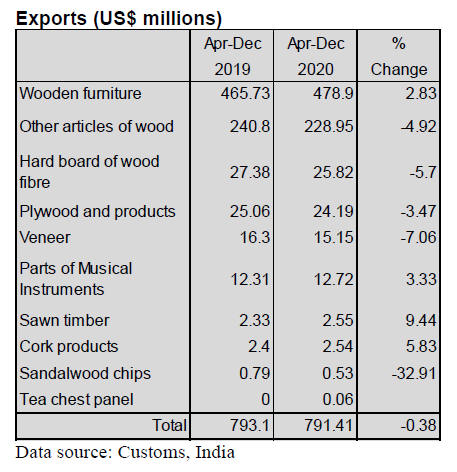
The latest wood product export data for the period
April to
December 2020 reveals a slight decline compared to the
same period in 2019. From March 2020 exports dropped
due to the pandemic and sluggish global demand.
In April the IHS Markit India Manufacturing Purchasing
Managers’ Index (PMI) rose to 55.5 after falling to a
seven-month low in March as new export orders grew the
fastest since October.
See:
https://www.business-standard.com/article/economypolicy/manufacturing-pmi-up-marginally-growth-of-domesticorders-production-slow-121050400043_1.html
Second wave a set back to housing market
The economies in many states have now begun to suffer
from the consequences of the second and serious wave of
corona virus infections and the real estate sector is one that
has been affected. The housing market started to recover
after the 2020 pandemic but this second wave has come as
a shock and home sales have fallen sharply and project
launches have been delayed.
Potential homebuyers have become very cautious in view
of the current virus situation and a number of transactions
have been put on hold as consumers cut back on outlays as
they are uncertain how long it will take to overcome the
current disaster. A recent Anarock Property Consultants
report suggests that the current virus outbreak, along with
the expiry of the free stamp duty period, impacted growth
in the housing market.
See:
https://www.financialexpress.com/money/a-year-since-thepandemic-mapping-real-estate-sectors-growth-journey/2241136/
Printed homes
Part of the solution to India’s acute shortage of affordable
homes could be in 3-D printed structures. A roughly 60
sq.m home was recently created by Tvasta Manufacturing
Solutions in Chennai in collaboration with the NGO
Habitat for Humanity’s Terwilliger Center for Innovation
in Shelter.
The concrete used in this 3D printing is specially
formulated for faster drying times, allowing Tvasta to
build these homes more quickly and efficiently than
traditional construction. Adithya Jain, the Tvata CEO said
a home can be built in under a week .
See:
https://www.habitat.org/stories/investing-innovation-india
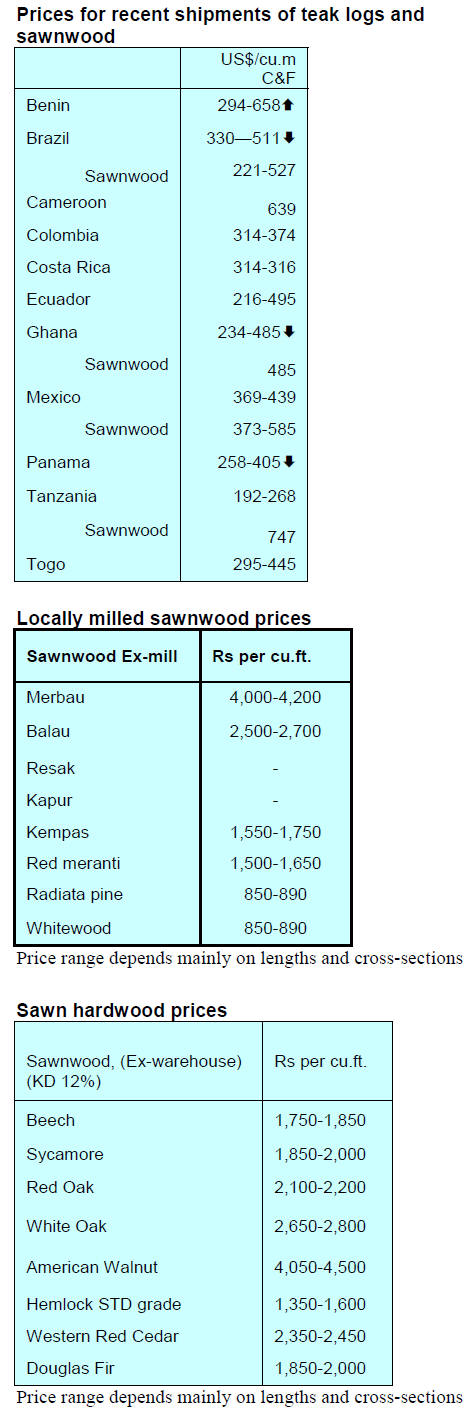
Plywood
The Indian trade magazine Plyreporter has highlighted the
current plight of Kerala based plywood mills that now face
an acute shortage of workers which is disrupting
production.
The problem is that Kerala plywood mills rely heavily on
migrant laborers mostly from Assam and West Bengal.
These workers, it seems, have returned home to participate
in assembly elections and because this is the marriage
season in both states.
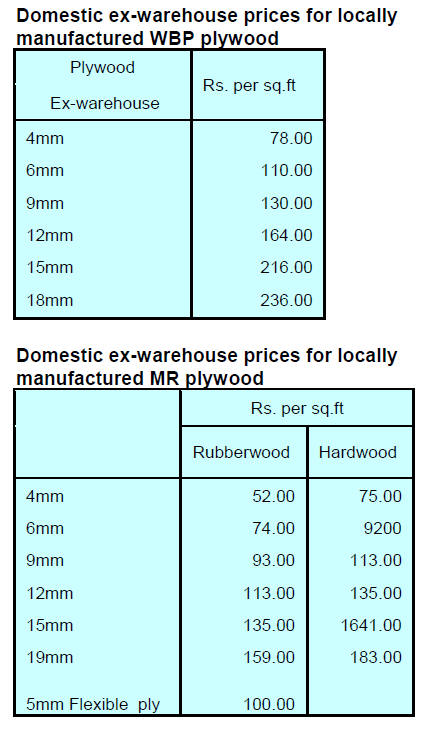
Revising the Forestry Act revisited
On 8 April this year the Ministry of Environment, Forest
and Climate Change called for ‘Expression of Interest’ for
shortlisting consultancy companies that could prepare a
draft comprehensive amendment to the Indian Forest Act
1927 created in pre-independent India.
The objective of this latest exercise is to prepare a “draft
of the comprehensive amendment of Indian Forest Act,
1927” in consultation with state governments and union
territories, central government ministries and other
stakeholders according to the Ministry.
See:
http://moef.gov.in/wp-content/uploads/2021/04/MoEFCCinviting-EOI-for-draft-amendments-to-IFA.pdf
and
https://science.thewire.in/environment/unbent-indiangovernment-trying-to-amend-the-indian-forest-act-1927-again/
7.
VIETNAM
Vietnam's import of tropical timber from Africa
Volume and value of tropical timber imported from all
sources
Vietnam imports tropical timber from Africa, South
America, SE Asia and PNG to meet the demand of local
consumers who still prefer the hardness and durability of
tropical timber.
In 2020, the volume of tropical timber imported into
Vietnam from all tropical areas totalled 2.7 million cubic
metres, accounting for 41% of total log and sawnwood
imports from all sources.

The share of tropical timber against the total
volume of
timber imported into Vietnam has been declining. In 2015,
tropical log and sawnwood accounted for 54% of total
imports from all sources. By 2020, this share dropped
down to 41%.
However, this does not mean that the volume of tropical
timber has decreased as the total imports have been
increasing rapidly. The growth of non-tropical timber
import has been much higher than that of timber imported
from the tropics.
Tropical timber imported from Africa into Vietnam
African countries are the main suppliers of tropical timber
to Vietnam with some 20 countries selling annually about
1.3 cu.m of tropical timber to Vietnam.
The volume of tropical timber imported from Africa into
Vietnam accounts for about a quarter of the total log and
sawnwood that Vietnam has been importing in recent
years (see Table below).
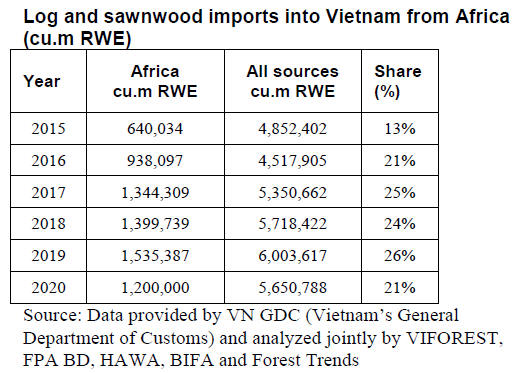
African countries are the top supplier of tropical
logs to
Vietnam. Due to Covid-19 pandemic, the African supply
of tropical timber has slightly reduced. However, Africa
remains the most important supplier of tropical timber for
Vietnam.
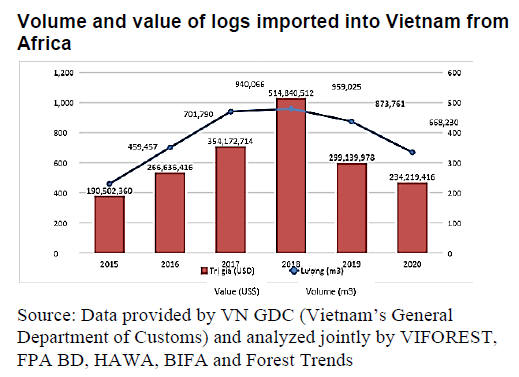
Log suppliers
At present, there are some 20 African countries selling
logs to Vietnam and contributing 33% of the total volume
of logs imported into Vietnam. The top 5 suppliers are
Cameron, Ghana, Democratic Republic of the Congo,
Nigeria and Congo. These 5 countries account for 86% of
the total volume of tropical logs Vietnam imports from
Africa in 2020.
On average, Vietnam annually imports over 400,000 cu.m
of logs from Cameroon. This is the largest tropical log
supplier contributing nearly 60% of the total log Vietnam
imports from Africa and over 21% of the log imported into
Vietnam from all sources.
The major woody species are tali/iron-wood (67%), sapele
(12%) and mahogany (6%).
Ghana is the second largest supplier of African logs to
Vietnam with an annual supply of over 50,000 cu.m,
corresponding to over 7% of the total import from Africa.
In 2020 imports declined to 31,570 cu.m. Mahogany tops
the imports (69%) followed by tali/iron-wood (34%) and
padouk (5.5%).
Nigeria is also amongst the major suppliers of tropical logs
for the Vietnamese market with shipments of 71,000 cu.m
in 2020 accounting for between 6-12% of the total log
imports from Africa. In 2018, Nigeria exported to Vietnam
94,210 cu.m of log, while in 2020 the export volume
dropped to 71,910 cu.m. Species imported from Nigeria
include mahogany (50%), padouk (46%) and tali (2.5%).
In 2015, the DRC shipped 5,150 cu.m of logs to Vietnam
equal to 1% of logs imported from Africa. However, in
2020, DRC exported 64,550 cu.m, accounting for 10% of
logs Vietnam imported from Africa. The main species
imported are tali/iron-wood (35%), sapele (20%) and
padouk (10%).
On average, Congo annually supplies over 20,000 cu.m of
log to Vietnam, accounting for 2-4% of the total log
volumes Vietnam imports from Africa. In 2020, the import
from Congo decreased to 18,140 cu.m. The main imported
species are tali, padouk, rose-wood and mahogany.
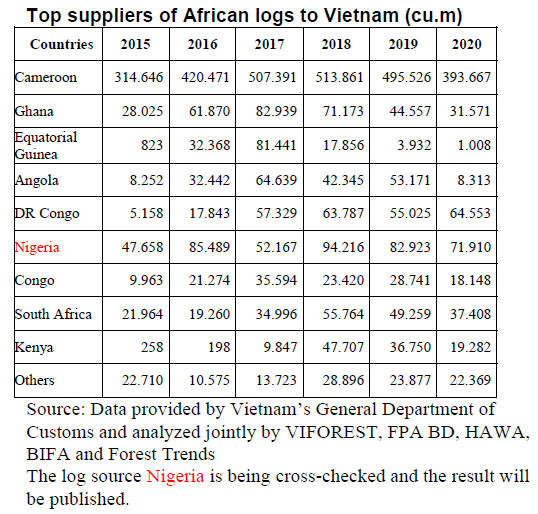
Log species imported
Vietnam has been importing about 90-100 species in log
form from Africa. Among them, 10 species are imported
in large volume, including tali/iron-wood, mahogany,
sapele, padouk, iroko, eucaliptus, iroko, rose-wood, and
dossie. These are the common timber species of Africa.
They contribute over 90% of the total supply. The volume
and value of top species imported are as follows:
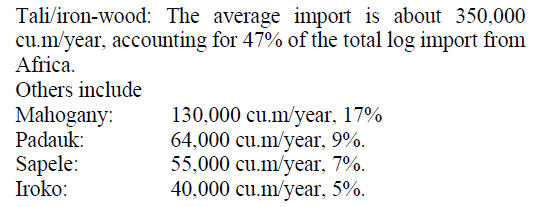
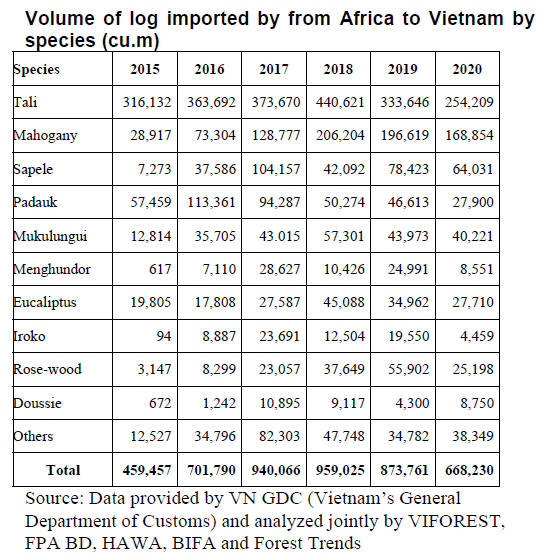
Sawnwood imports from Africa
African countries are the main suppliers of tropical
sawnwood to Vietnam. The volume of sawnwood
imported from African countries in 2020 was reported at
372,000 cu.m corresponding to 15% of the total volume of
sawnwood imported from all countries.
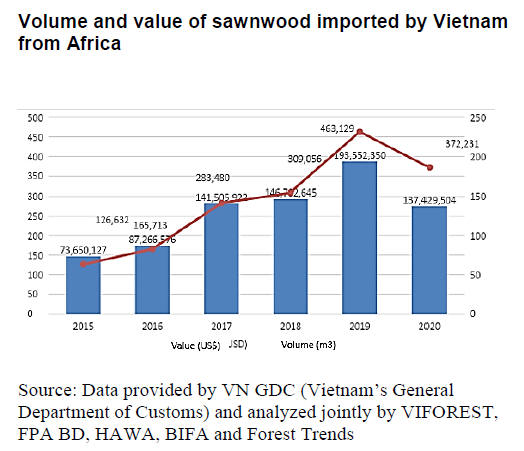
Sawnwood suppliers
Among some 20 countries supplying sawnwood to
Vietnam, Gabon, Cameroon, Nigeria, Ghana, Angola and
South Africa are the 6 main supply countries accounting
for around 90% of the total sawnwood imports from
Africa.
Cameroon leads the supply with fast growing export
volumes. On average, each year this country supplies over
100,000 cubic metres of sawnwood to Vietnam.
In 2015 sawnwood imported from Cameroon accounted
for 27% of the total import from Africa.
This figure increased to 41% by 2020. In 2020 imports
declined but still remained at quite a substantial volume
(153,630 cu.m).
The main species are tali, mahogany, padauk and sapele
with Tali topping imports at 60% of the total volume of
sawnwood imported from Cameroon, followed by doussie
(22%), padauk (9%) and sapele (1.5%).
Following Cameroon, Gabon is the next supplier of sawn
timber, exporting over 70,000 cubic metres per year to
Vietnam.
In 2015, Gabon exported 50,980 cu.m, accounting for 40%
of the total import from Africa. In 2020, due to the
pandemic, imports fell to 50,740 cu.m, equal to 14% of the
total import of sawnwood from Africa. The main imported
species from Gabon are tali (77%), menghundor (7%),
padauk (7%) and rose-wood (4%).
Nigeria supplies nearly 24,000 cubic metres of sawnwood
to Vietnam annually accounting for 7-14% of total
sawnwood imports from Africa. In 2020, Nigeria provided
36,400 cu.m, showing an increase of 18% compared to
2019. The main timber species imported from Nigeria
include Mahogany (51%), padauk (32%) and tali (15%).
Ghana exports over 20,000 cubic metres of sawnwood to
Vietnam each year. In 2020, Vietnam imported about
14,900 cu.m of sawnwood from Ghana, a decline of 24%
compared to 2019. The imported species are mahogany
(58%) and tali (34%).
Angola supplies over 10,000 cubic metres of sawnwood to
Vietnam sharing about 3-4% of the total import from
Africa. In 2020, 26,410 cu.m were exported to Vietnam.
The main export species are rose-wood, padauk and sapele
with rose-wood accounting for 63% of the total export,
followed by padauk (4.5%) and sapele (4%).
South Africa appears as a more and more important source
of sawnwood for Vietnam with rapid growth. In 2016, the
import from South Africa was about 1,000 cu.m. In 2020,
the import volume increased to nearly 50,000 cu.m,
accounting for 13% of the total volume of sawnwood
imported from Africa.
The main species of sawnwood imported from South
Africa into Vietnam are rose-wood, eucalyptus and
doussie, with rose-wood accounting for 95% of total
sawnwood imports from this country.
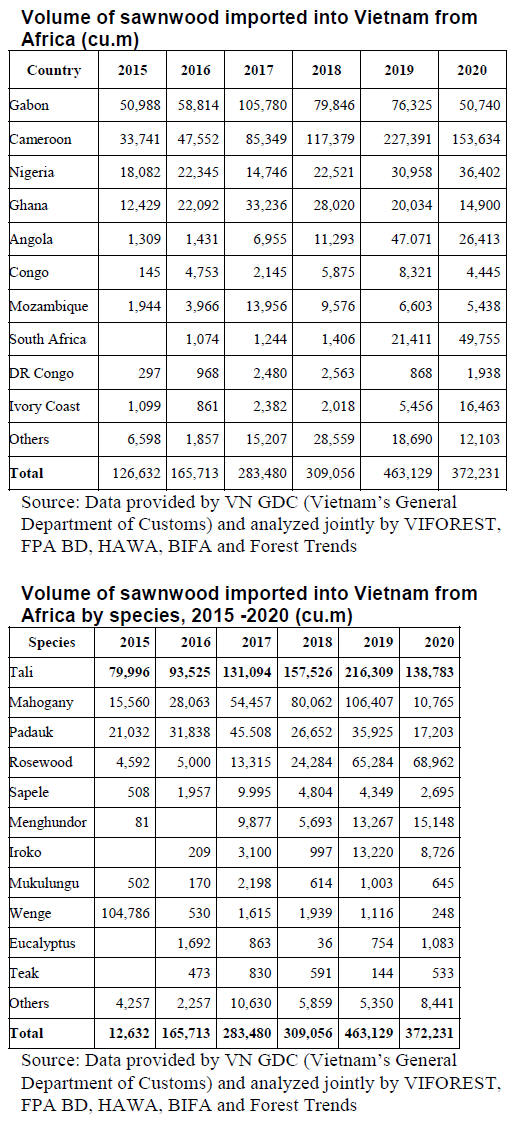
Similar to log imports, over 100 species of sawnwood
are
currently imported from Africa to Vietnam. However,
there only 5 species accounting for 90% of the total
import, including tali, mahogany, padauk, rose-wood and
sapele. Of these 5 species, tali is top with yearly import
volumes of over 130,000 cu.m accounting for nearly half
of the total timber import of tropical sawnwood from
Africa into Vietnam.
VNTLAS with new requirements on timber import
In Vietnam, Decree 102 issued by the Government to
operate VNTLAS became effective from 31 October,
2020. Following this Decree, overseas suppliers of timber
for Vietnam have been classified into countries of active
geographic areas and non-active geographic areas.
With this classification in place out of over 100 countries
having timber export to Vietnam, there are 51 countries
attributed to active geographical areas. At present, out of
all African countries which are exporting tropical timber
to Vietnam, South Africa alone is listed as the country of
active geographic areas.
To tighten the control over the legality of timber imports
Decree 102 also classified import species into risk and low
risk groups. Risk species encompass those that are either
imported into Vietnam for the first time or listed by
CITES or are endangered species.
In addition to currently applicable documents including
Sale Contract, Packing List, Bill of Lading, Quarantine
Certificate and Certificate of Origin, with the newly issued
Decree to operate VNTLAS before clearing customs
formalities importers may be asked to provide additional
evidence to prove timber legality such as logging license
(if applicable in sourcing countries), SFM certificate,
timber processing/transportation license etc.
8. BRAZIL
Using technology to detect illegal
timber
The Federal Police (PF) recently used two technologies
that have been found very effective in the fight against
illegal logging:
a new satellite monitoring system, called
‘Planet Lab’
a tool that identifies the DNA of the tree
The technologies were used in two of the largest
operations to combat illegal logging, the Archimedes
Operation and the Handroanthus GLO Operation. The
operation was named Handroanthus GLO because it is the
scientific name of golden trumpet tree (ipê) the most
targeted tree by smugglers in the Amazon.
Using DNA methods the police can check the exact
location from where the timber originated. ‘Planet Lab’
utilises high resolution satellite images can allow for cross
referencing of field harvesting against the forest
management plan.
Partnerships in furniture development in Mato Grosso
The Center for Timber Producers and Exporters of Mato
Grosso State (CIPEM) recently met with the Federation of
Industries of Mato Grosso State (FIEMT), the Union of
Timber Industries of Mid-North Region of Mato Grosso
(SINDINORTE) and the Furniture Industry Union of Mato
Grosso State (SINDIMÓVEL/MT) to discuss the issue of
ensuring furniture manufacturers to have access to timber
raw material supplies.
One of the concerns discussed was the source of timber
used by the furniture sector as the state of Mato Grosso
has a range of timber species of excellent quality and
suitable for furniture manufacturing.
Representatives of SINDIMÓVEL/ MT stated that its
main suppliers are from other states despite there being
high quality raw material available within the state.
Among the challenges identified to limit the need to use
timber from other states was quality, reliability,
dimensioning of parts and continuous supplies.
Closer collaboration between the timber industry unions
and furniture industry unions will boost confidence
between the buyer and seller and together they can address
the issue of quality improvement.
It was decided that FIEMT will carry out a study to
identify how best to bring the primary producers and
furniture industries together so as to strengthen the state
economy.
Roundwood among main Brazilian agribusiness
exports
Exports of roundwood are among the top agribusiness
exports when comparing the percentage of the main
commodity exports according to the Secretariat of Foreign
Trade (Secex).
In the first four months of 2021 export shipments of
roundwood were almost double that of the same period in
2020 totalling US$ 66 million. By way of comparison
soybean exports (17.4 million tonnes) were worth US$7.2
billion, a record for the country.
Exports in the first quarter 2021
The Brazilian Association for Mechanically Processed
Timber (ABIMCI) has reported that in the first quarter of
this year timber exports have increased compared to Q1
2020.
Tropical plywood exports increased with the United States
being the main market. Tropical sawnwood exports in the
first quarter also increased with Vietnam being a major
buyer.
Wooden flooring exports increased by around 30% with
the US responsible for 64% of the all exports. Exports of
wooden doors grew 7% year on year in the first quarter
with over 80% being shipped to the US. Exports of pellets
declined year on year in the first quarter of 2021 but it has
been noticed that pellet exports fluctuate more widely than
has been seen for other wood products.
Brazil’s exports of pine veneer fell 5% year on year in the
first quarter while tropical veneer exports dropped 12% in
the same period. Malaysia is a major buyer of both
products accounting for a share of around 30% for pine
veneer and 50% for tropical veneer.
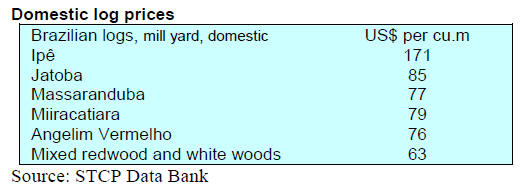

9. PERU
Modernising Peru’s forestry sector
Andina, the Peruvian news agency has reported
the Governments’ of Peru and the United States have
agreed a Memorandum of Understanding that will enable
the development of joint action for the modernisation of
the Peruvian forestry sector through sustainable, inclusive,
responsible and profitable economic growth.
See:
https://andina.pe/agencia/noticia-peru-us-agree-to-joinefforts-for-modernization-of-forestry-sector-842193.aspx
Semi-manufactured wood product exports begin to
recover
The Exporters Association (ADEX) has reported that
exports of semi-manufactured wood products in the first
two months of this year were worth US$10.6 million, up
8% compared to the same period in 2020 (US$9.8
million).
ADEX says most of the recovery was due to major
purchases by French importers who bought wood products
valued at US$3.1 million compared to the US$1.6 million
in the same period in 2020.
The other major markets in the first two months of this
year were China (US$4.2 million, down 6%) followed by
Denmark (-34.6%), Belgium (30%), USA (46%), New
Zealand (-55%), Netherlands (544%), Germany (11.6%),
Australia (22.5%) and Mexico (-70.3%).
The main export items were tropical wood moldings
(except ipé) US$4.3 million, slats and friezes for
unassembled parquet (US$2.4 million) and other profiled
(US$2.1million). These three products accounted for 82%
of the total.
Exports of semi-manufactured products topped exports of
sawnwood in the first two months of 2021 and overtook
exports of construction products, furniture and parts and
veneers and plywood.
Forest Account shows contribution to the economy
The National Forest and Wildlife Service (Serfor) and the
National Institute of Statistics and Informatics (INEI)
presented details of the ‘Forest Account for Peru’ which
show that the forestry sector contributed 1.04% to GDP in
2020.
In 2019, INEI estimates only considered the value of
forestry (wood) as a contribution from the forestry sector
and concluded a modest 0.15%.
The Forest Account is a key tool for policy decisions in
the forestry and wildlife sector as it enhances available
statistics and indicators related to the sector and
demonstrates the value of the services provided by forests.
During the discussion of the Forest Account the Vice
Minister of Agricultural Development and Irrigation stated
that “through these indicators it will be shown, in
monetary terms, to what extent the forests located on the
coast, mountains and jungle of the country are part of the
livelihood of the population, industries, tourism, regional
economies and our country in general".
New programme for SFM forest production
Through an agreement between the Peruvian and German
governments the Ministry of Agrarian Development and
Irrigation will implement a programme for ‘Promotion and
Sustainable Management of Forest Production’. A sum of
around US$138 million will be allocted to benefit 2.7
million rural inhabitants of nine regions of the country
over the next five years.
The Minister said this is one of the largest forestry sector
investment programmes in the history of the country
aimed at reactivating productive forest economic activity
through sustainable management.
The programme will directly benefit nine regions: Ancash,
Cajamarca, Huánuco, Junín, Loreto, Madre de Dios,
Pasco, San Martín and Ucayali. The executing agency will
be the National Forest and Wildlife Service (Serfor).
Improving productivity of Amazon forest plantations
The Center for Research in Silviculture and Forest
Improvement (CESILMEF) of the National Agrarian
University La Molina (UNALM) and the National Institute
of Agrarian Innovation (INIA) with the support of the
National Fund for Scientific, Technological Development
and Technological Innovation have been executing a
research project called "Maderas 3".
The project seeks to obtain data on wood quality of eight
commercial species from native and exotic forest
plantations in the Amazon in order to construct growth and
productivity indicators as well as determining their
technological properties.
